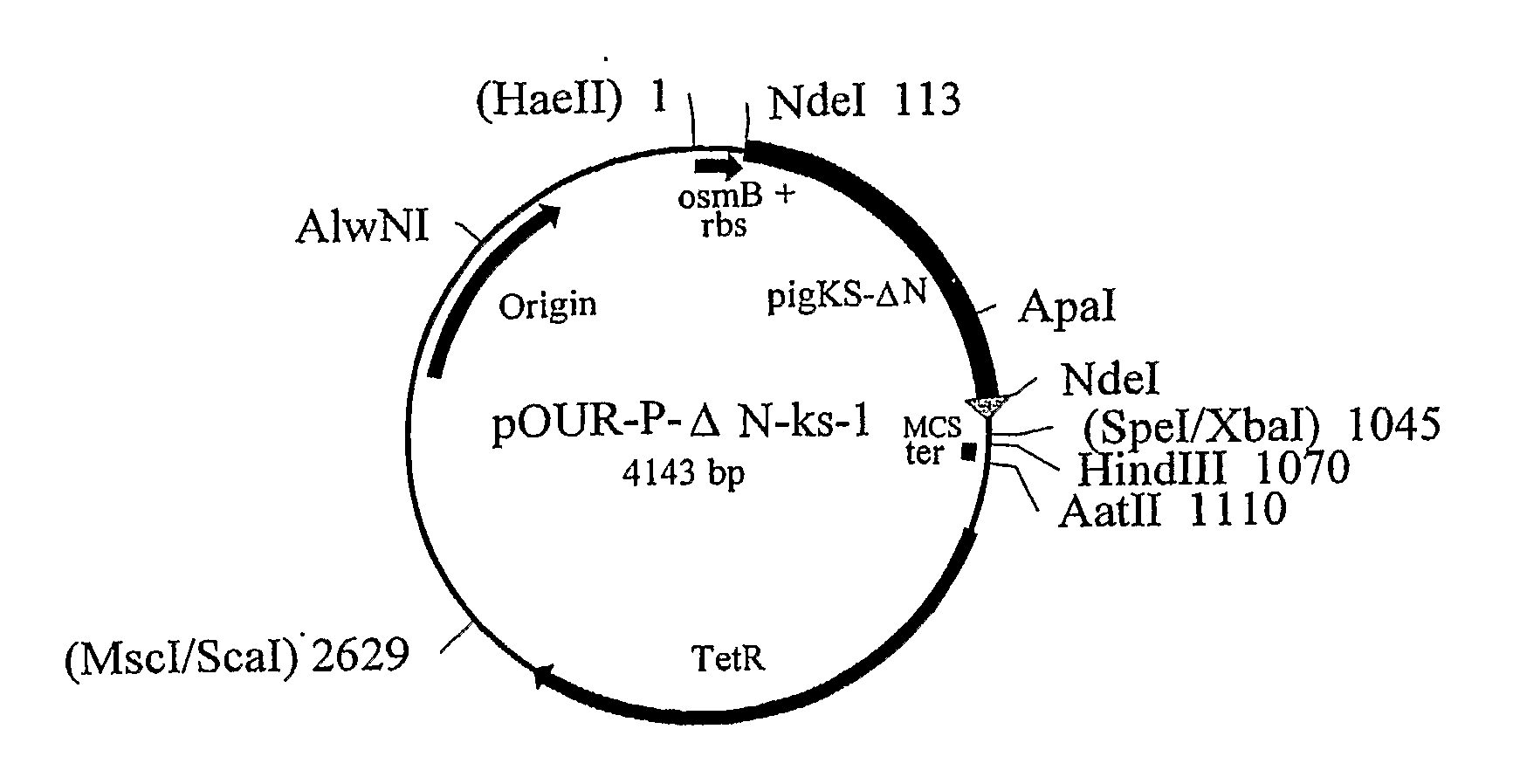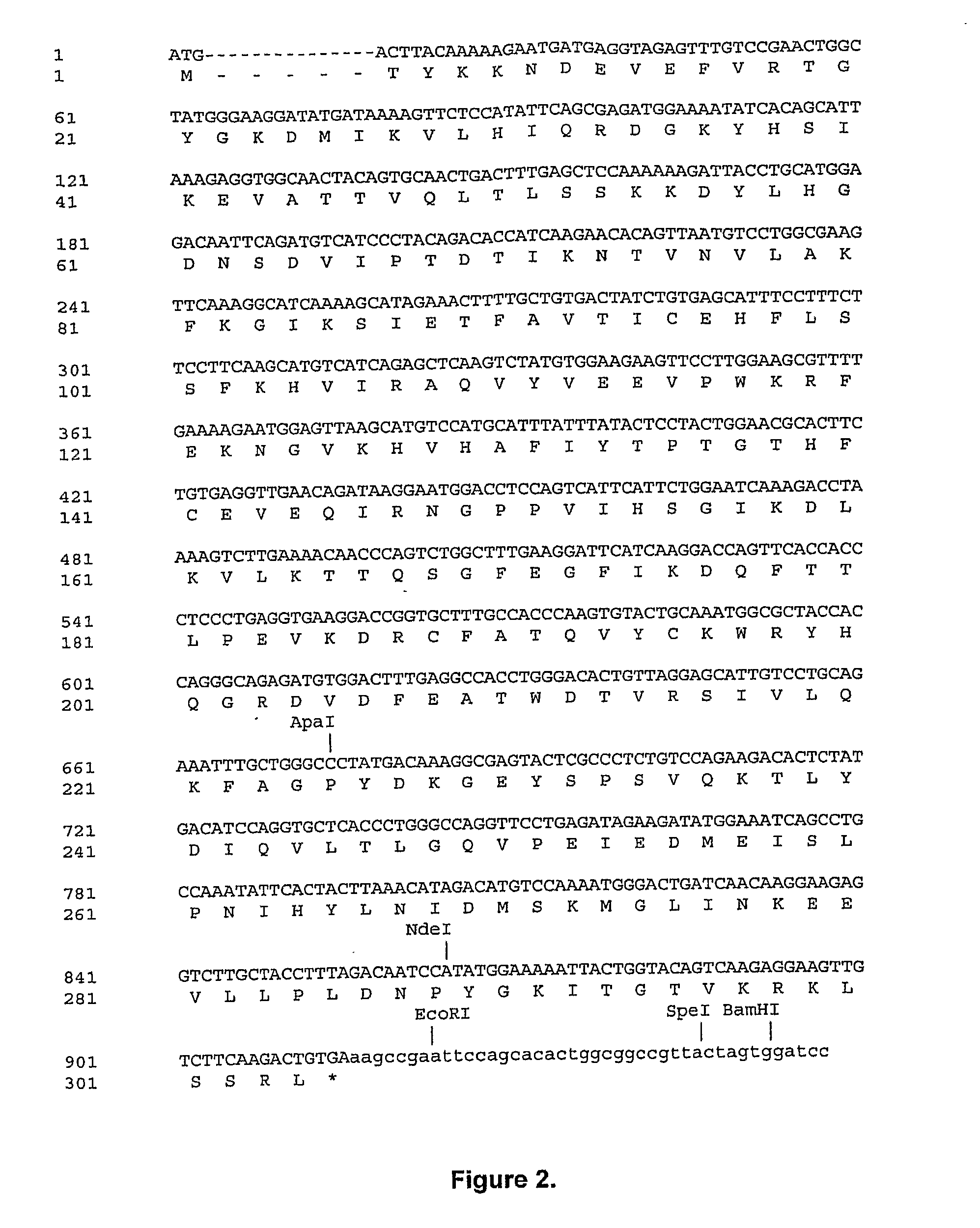Variant Forms of Urate Oxidase and Use Thereof
a uricolytic activity and urate technology, applied in the field of genetically modified proteins with uricolytic activity, can solve the problems of gout, tophi, disfiguring urate deposits, and renal failure, and achieve the effect of maintaining uricolytic activity
- Summary
- Abstract
- Description
- Claims
- Application Information
AI Technical Summary
Benefits of technology
Problems solved by technology
Method used
Image
Examples
example 1
Construction of Gene and Expression Plasmid for Uricase Expression
[0109]Recombinant porcine uricase (urate oxidase), Pig-KS-ΔN (amino terminus truncated pig uricase protein replacing amino acids 291 and 301 with lysine and serine, respectively) was expressed in E. coli K-12 strain W3 110 F−. A series of plasmids was constructed culminating in pOUR-P-ΔN-ks-1, which upon transformation of the E. coli host cells was capable of directing efficient expression of uricase.
Isolation and Subcloning of Uricase cDNA From Pig and Baboon Liver
[0110]Uricase cDNAs were prepared from pig and baboon livers by isolation and subcloning of the relevant RNA. Total cellular RNA was extracted from pig and baboon livers (Erlich, H. A. (1989). PCR Technology; Principles and Application for DNA Amplification; Sambrook, J., et al. (1989). Molecular Cloning: A Laboratory Manual, 2nd edition; Ausubel, F. M. et al. (1998). Current protocols in molecular Biology), then reverse-transcribed using the First-Strand c...
example 2
Transformation of the Expression Plasmid Into a Bacterial Host Cell
[0140]The expression plasmid, pOUR-P-ΔN-ks-1, was introduced into E. coli K-12 strain W3110 F−. Bacterial cells were prepared for transformation involved growth to mid log phase in Luria broth (LB), then cells were harvested by centrifugation, washed in cold water, and suspended in 10% glycerol, in water, at a concentration of about 3×1010 cells per ml. The cells were stored in aliquots, at −70° C. Plasmid DNA was precipitated in ethanol and dissolved in water.
[0141]Bacterial cells and plasmid DNA were mixed, and transformation was done by the high voltage electroporation method using Gene Pulser II from BIO-RAD (Trevors et al (1992). Electrotransformation of bacteria by plasmid DNA, in Guide to Electroporation and Electrofusion (D. C. Chang, B. M. Chassy, J. A. Saunders and A. E. Sowers, eds.), pp. 265-290, Academic Press Inc., San Diego, Hanahan et al (1991) Meth. Enzymol., 204, 63-113). Transformed cells were susp...
example 3
Recombinant Uricase Preparation
[0142]Bacteria such as those transformed (see above) were cultured in medium containing glucose; pH was maintained at 7.2±0.2, at approximately 37° C.
[0143]Towards the last 5-6 hours of cultivation, the medium was supplemented with KCl to a final concentration of 0.3M. Cultivation was continued to allow uricase accumulation.
[0144]Recombinant uricase accumulated within bacterial cells as an insoluble precipitate similar to inclusion bodies (IBs). The cell suspension was washed by centrifugation and suspended in 50 mM Tris buffer, pH 8.0 and 10 mM EDTA and brought to a final volume of approximately 40 times the dry cell weight.
[0145]Recombinant uricase-containing IBs, were isolated by centrifugation following disruption of bacterial cells using lysozyme and high pressure. Treatment with lysozyme (2000-3000 units / ml) was done for 16-20 hours at pH 8.0 and 7±3° C., while mixing. The pellet was washed with water and stored at −20° C. until use.
[0146]The enr...
PUM
| Property | Measurement | Unit |
|---|---|---|
| Mass | aaaaa | aaaaa |
| Mass | aaaaa | aaaaa |
| Mass | aaaaa | aaaaa |
Abstract
Description
Claims
Application Information
 Login to View More
Login to View More - R&D
- Intellectual Property
- Life Sciences
- Materials
- Tech Scout
- Unparalleled Data Quality
- Higher Quality Content
- 60% Fewer Hallucinations
Browse by: Latest US Patents, China's latest patents, Technical Efficacy Thesaurus, Application Domain, Technology Topic, Popular Technical Reports.
© 2025 PatSnap. All rights reserved.Legal|Privacy policy|Modern Slavery Act Transparency Statement|Sitemap|About US| Contact US: help@patsnap.com



